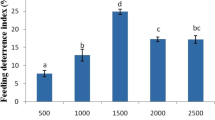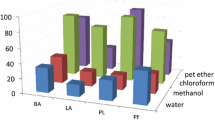Abstract
Antifeeding and toxic effects of chemical extracts from Porteresia coarctata Takeoka on the insect pest Spodoptera litura (F.) were investigated in the laboratory. Hexane extracts of P. coarctata leaves were re-dissolved in dimethyl sulfoxide and applied in water to leaves of Ricinus communis L. (castor). A concentration of 1,000 and 2,000 ppm extract exhibited significant antifeeding and toxic effects to third instar larvae when compared to the same concentration of dimethyl sulfoxide in water as control. One day after feeding on extract-treated castor leaves, the mortality of S. litura larvae was 50%. Mortality increased to 95% after 11 days at a dosage of 2,000 ppm. Compared to the control, third instar larvae fed on castor leaves treated with P. coarctata leaf extract at different concentrations showed significant reduction in protein and DNA content in the fat body and midgut tissues. Results demonstrate the insecticidal and antifeedant properties of P. coarctata leaf extract against the generalist pest S. litura leading to biochemical changes in the insect body. Thus, P. coarctata contains phytochemicals, and the extract, in crude and pure form, has potential as a botanical insecticide in alternative control strategies against Lepidoptera pests.


Similar content being viewed by others
References
Athanassiou CG, Kavallieratos NG, Economou LP, Dimizas CB, Vayias BJ, Tomanoovic S, Milutinovic M (2005) Persistence and efficacy of three diatomaceous earth formulations against Sitophilus oryzae (Coleoptera: Curculionidae) on wheat and barley. J Econ Entomol 98:1404–1412
Bandaranayake WM (1998) Traditional and medical uses of mangroves. Mangrove Salt Marsh 2(3):133–148
Bhattacharyya A, Saigopal DVR, Venkata-Prasanna TM, Sreenivasulu M, Raju S, Barik BR, Chatterjee NB, Gupta TK (2003) Premnazole, an extract of Premna integrifolia and its molecular implications on the physiology of silkworm Bombyx mori L. race nistari. J Palynology 39:207–213
Bomford MK, Isman MB (1996) Desensitization of fifth instar Spodoptera litura to azadirachtin and neem. Entomol Exp Appl 81:307–313
Ciccia G, Coussio J, Monelli E (2000) Insecticidal activity against Aedes aegypti larvae of some medicinal South American plants. J Ethnopharmacol 72:185–189
Deota PT, Upadhyay PR (2005) Biological studies of azadirachtin and its derivatives against polyphagous pest, Spodoptera litura. Nat Prod Res 19:529–539
Dureja P, Johnson S (2000) Photodegradation of azadirachtin-A: a neem based pesticide. Curr Sci 79:1700–1703
Fujimoto Y, Morisaki M, Ikekawa N (1980) Stereochemical importance of fucosterol epoxide in the conversion of sitosterol into cholesterol in the silkworm Bombyx mori. Biochemistry 19:1065–1069
Guha Bakshi DN, Sanyal P, Naskar KR (eds.) (1999) Chapter 14: Studies on the utilities of saline resistant wild rice, Porteresia coarctata (Roxb.) Takeoka from the newly silted up river flats of Indian Sundarbans. In: Sundarbans Mangal, Vedams Books, p 771, ISBN: 81-85421-55-2
Herlt AJ, Lewis NM, Emma P, Raymond JR, Ponis T (2002) Two major saponins from seeds Barringtonia asiatica: putative anti-feedants towards Epilachna sp. larvae. J Nat Prod 65:115–120
Jacobson M (1989) Botanical insecticides: past, present and future. In: Arnason JT, Philogene BJR, Morand P (eds) Insecticides of plant origin. ACS Symp Ser No. 387, Washington DC, pp 1–10
Jagtap TG (1985) Ecological studies in relation to the mangrove environment along the Goa Coast, India, PhD Thesis. Shivaji University, Kolhapur, India
Jagtap TG, Bhosale S, Charulata S (2006) Characterization of Porteresia coarctata beds along the Goa coast, India. Aquat Bot 84:37–44
Jana TK, Choudhuri R, Choudhuri A (1990) Net primary production, turnover and transpiration efficiency of Porterasia coarctata Takeoka in Sundarban mangrove swamps, India. In: International conference on high salinity: tolerant plants in arid regions, Al-Ain, UAE, p 21
Jena M (2000) Efficacy of the plant Polygonum hydropipe against rice brown plant hopper, Nilaparvata lugens Stahl. Curr Sci 78:952–954
Koul O (2004) Biological activity of volatile di-N-propyl-disulfide from seeds of neem, Azadirachta indica (Meliaceae), to two species of stored grain pests Sitophilus oryzae (L.) and Tribolium castaneum (Herbst). J Econ Entomol 97:1142–1147
Lowery DT, Isman MB (1995) Toxicity of neem to natural enemies of aphids. Phytoparasitica 23:297–306
Lowry OH, Rosenbrough NJ, Farr AN, Randall RJ (1951) Protein measurement with the folin phenol reagent. J Biol Chem 193:265–275
Majee M, Maitra S, Dastidar KG, Pattnaik S, Chatterjee A, Hait NC, Das KP, Majumder AL (2004) A novel salt-tolerant l-myo-inositol-1-phosphate synthase from Porteresia coarctata (Roxb.) Tateoka, a halophytic wild rice: molecular cloning, bacterial overexpression, characterization, and functional introgression into tobacco-conferring salt tolerance phenotype. J Biol Chem 279:28539–28552
Misra S, Choudhury A, Chattopahdyay A, Ghosh A (1988) Lipid composition of Porteresia coarctata from two different mangrove habitats in India. Phytochemistry 27:361–364
Munro HN (1966) The determination of nucleic acids. In: Methods of biochemical analysis. Interscience, New York, pp 113–176
Prasada Rao CG, Ray A, Ramamurty PS (1983) Biochemical studies on DNA, RNA and protein contents of the labial glands during postembryonic development of Spodoptera litura (Noctuidae: Lepidoptera) Entomon 8:71–74
Ray A, Prasada-Rao CG, Sridevi R, Ramamurty PS (1984) Changes in acid phosphatase activity in Spodoptera litura (Noctuidae: Lepidoptera) during the post embryonic and adult development. Entomon 9:161–167
Rodriguez-Saona CR, Trumble JT (1999) Effect of avocado furans on larval survival, growth and food preference of the generalist herbivore, Spodoptera exigua. Entomol Exp Appl 90:131–140
Sadek MM (1997) Antifeedant and larvicidal effects of Eichornia crassipes leaves on the cotton leaf worm Spodoptera littoralis (Boisd.) J Egypt Ger Soc Zool 24:209–232
Sadek MM (2003) Antifeedant and toxic activity of Adhatoda vasica leaf extract against Spodoptera littoralis (Lepidoptera: Noctuidae). J Appl Entomol 127:396–404
Sambrook J, Russell DW (2001) Molecular cloning—a laboratory manual, 3rd edn. Cold Spring Harbor, New York, pp A8.40–A8.51
Sharma AK, Seth RK (2005) Combined effect of gamma radiation and azadirachtin on the growth and development of Spodoptera litura (Fabricius) Curr Sci 89:1027–1031
Sridevi R, Ray A, Ramamurty PS (1988) 20-hydroxy-ecdysone stimulated DNA synthesis in early larval testes of Spodoptera litura (Noctuidae: Lepidoptera). Invertebr Reprod Dev 14:199–201
Suganthy M, Philipsridhar R, Nagapasupathi N, Baskaran V (2005) Bioefficacy of selected plant extracts on Spodoptera litura (Lepidoptera) and Aphis craccivora (Hemiptera). J Ecotoxicol Environ Monit 15: 151–155
Tapondiou AI, Adler C, Fontem DA, Bouda H, Reichmuth Ch (2005) Bioactivities of cymol and essential oils of Cupressus sempervirens and Eucalyptus saligna against Sitophilus zeamais Motschulsky and Tribolium confusum du Val. J Stored Prod Res 41:91–102
Ulrichs Ch, Mewis I (2004) Seasonal abundance of two armyworm species, Spodoptera exigua (Hübner) and Spodoptera litura (F.) in the Philippines. Commun Agric Appl Biol Sci 69:323–328
Venkatswarlu B, Mulkhopadhyaya J (1999) Azadirachtin content in the seed of micro-propagated neem plants in relation to the mother tree. Curr Sci 76:626–627
Xingwei H, Paul F, Joel PM, James B (2004) Control of stored product beetles with combinations of protein rich pea fluor and parasitoids. Environ Entomol 33:671–680
Acknowledgments
The authors wish to acknowledge the help of Dr. A. Samanta, Redear, Entomology Department, Prof. A. K. Das, Dean of Studies of the Bidhan Chandra Krishi Viswavidyalaya and Dr. J. R. Burleigh for critical reading and suggestions for the improvement of the manuscript. The authors are also grateful to Prof. M. Ghose of Indian Statistical Institute for the supply of the P. coarctata leaves from the mangrove forests of Sunderbans, West Bengal, India.
Author information
Authors and Affiliations
Corresponding author
Rights and permissions
About this article
Cite this article
Ulrichs, C., Mewis, I., Adhikary, S. et al. Antifeedant activity and toxicity of leaf extracts from Porteresia coarctata Takeoka and their effects on the physiology of Spodoptera litura (F.). J Pest Sci 81, 79–84 (2008). https://doi.org/10.1007/s10340-007-0187-4
Received:
Revised:
Accepted:
Published:
Issue Date:
DOI: https://doi.org/10.1007/s10340-007-0187-4




